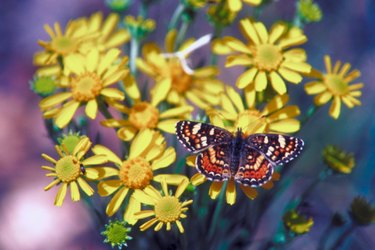
The life cycle of a butterfly begins with the egg. According to the University of Rhode Island, butterflies can lay from 200 to 1,500 eggs, which hatch into larvae, or caterpillars. The caterpillar eats the leaves or other parts of the plant that it hatches on. Some species can be sustained only on one type of plant or part of a plant, while others have a variety. The caterpillar then goes into the pupal stage, forms a cocoon and eventually transforms into a butterfly.
Milkweed
Video of the Day
Monarch butterflies have intricate black and orange colored patterns and are easy to identify. Monarchs have only one suitable host plant: milkweed. Milkweed produces broad leaves as well as pods that contain fluffy white material that allows seeds to disperse when the pods open. Milkweed leaves produce a poison that does not bother the caterpillar but makes it poisonous to predators. If you enjoy butterflies in your yard and garden, it pays to let a few weeds like milkweed grow.
Video of the Day
Stinging Nettle
The red admiral has red and white markings on a brown to black background. Commonly found across the United States, this butterfly prefers to lay its eggs on stinging nettle. Considered a particularly undesirable weed because of the stinging sensation produced when accidentally touched, stinging nettle is the only plant red admiral will lay eggs on. The satyr comma, a bright yellow orange butterfly with black and brown spots, also exclusively prefers stinging nettle.
Flowers
The less choosy painted lady butterfly prefers thistle, sunflower, pearly everlasting or hollyhock. Painted ladies are brown and orange with white spots and would make an attractive sight in any garden. If you wish to encourage a variety of butterflies, add bleeding heart to attract American apollo. Brown elfins prefer rhododendrons and azaleas. Try planting lupine to attract silvery blues.
Trees
The mourning cloak butterflies are beautifully colored with dark burgundy, yellow and blue with a light border. Mourning cloaks like to lay eggs on tree leaves including elm, cottonwood, willow and birch. Western tiger swallowtails show preference to willow, aspen and cottonwood. Pine whites, true to their name, like pine, fir and hemlock.